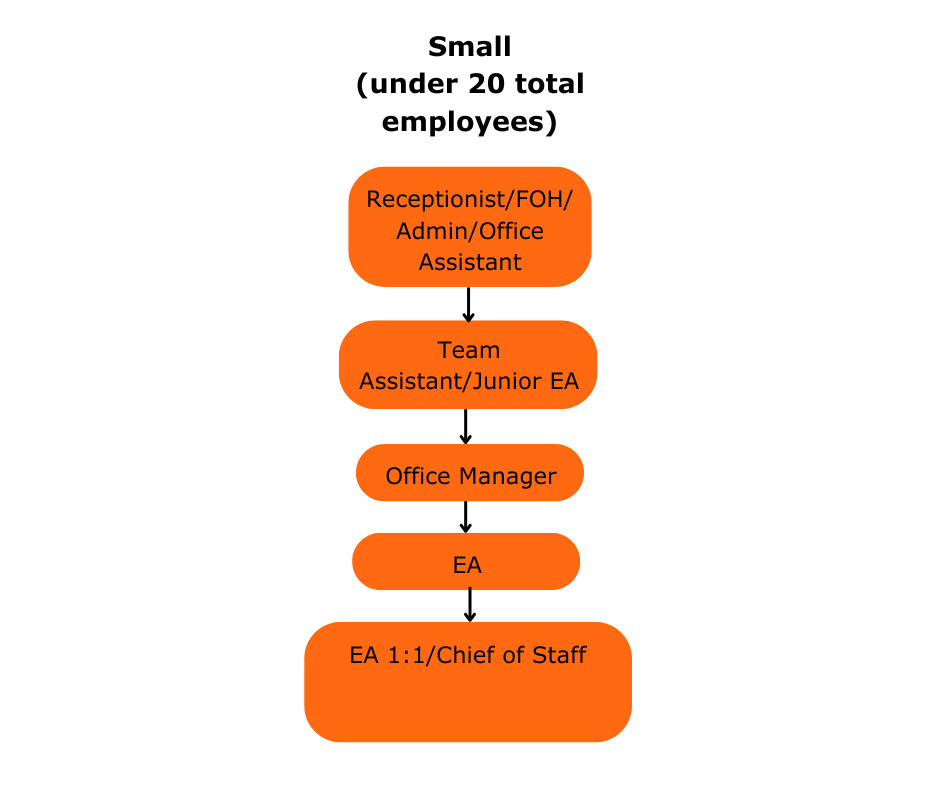If you’re looking to hire an EA or you have EAs within your employment, it’s helpful to have a full understanding of an executive assistant’s career path. This includes the roles that lead to a EA and the potential positions it can lead to.
Why is it important? By having this overview, hiring managers can zero in on candidates best qualified to step into an EA role, and show prospective talent the opportunities they will have to grow professionally. This will make the role more desirable to exceptional EAs and help foster a sense of loyalty once they are in the job.
What is an Executive Assistant (EA)?
An executive assistant provides administrative support to one or more members of staff at a business, typically those in senior management. EAs can also be hired by private individuals to assist in personal matters, such as diary management and household management.
Key Responsibilities of an Executive Assistant
Executive assistants’ tasks and responsibilities can cover a wide range of requirements which will differ depending on the manager’s preferences. However, there are several tasks that almost all EAs will be expected to carry out. The main responsibilities of an EA generally include:
- Diary management
- Booking meetings
- Booking travel and accommodation
- Budget and expenses management
- Creating reports and presentations
- Minute-taking
Skills and Competencies of Successful Executive Assistants
In order to carry out their varied duties successfully, there are some key skills that executive assistants possess. Some of these may include character traits, while other skills will have been developed in an EA’s early career, for example when they might have been an administration assistant or receptionist. Some of the essential skills and competencies include:
- Written and verbal communication
- Organization
- Timekeeping
- MS office literacy
- Sociability
These skills are invaluable to an executive assistant throughout their career, whether they move on to become an executive assistant, business assistant, or chief of staff. Therefore, it’s crucial to build on these learning and development opportunities so that EAs can continue to hone their abilities and progress.
Career Progression Paths for Executive Assistants
Various junior and entry-level business support roles can progress into executive assistant positions , and the EA role can likewise branch out into an equally varied pool of senior role titles. The breadth of opportunities for EAs is often dependent on the size of a business, with smaller companies naturally having less specialized roles at each stage of the career journey.
EA Career Progression in SMBs

EA Career Progression in medium-sized businesses

EA Career Progression in Large Corporations

Job descriptions
Having a detailed job description template on file for all your administrative positions, from receptionist through to team assistant, EA and business assistant will help to streamline the recruitment process. Significantly, it also helps to demonstrate the career journey and highlight the key competencies required to progress into each role. Having a visual road map will help both the employer and employee to plan an EA’s career progression.
We have compiled general job descriptions, from entry-level assistant roles to more senior positions, ready for you to adapt to your needs.
Receptionist job description
Responsibilities:
- Meeting and greeting clients and visitors
- Answering phone calls, taking messages and relaying to appropriate staff
- Logging, sending and distributing all incoming and outgoing mail, couriers and faxes
- Arranging delivery of outgoing mail
- Booking, preparing and tidying meeting rooms
Requirements:
- Excellent written and verbal communication
- Clear and confident telephone manner
- Computer skills, including Word and Outlook
Office administrator job description
Responsibilities
- Assisting the office manager
- Manage general office maintenance and health & safety
- Arrange desk space and office access for new employees
- Extensive email correspondence, occasionally covering colleagues’ mailboxes
- Invoice and expenses management
- Arrange catering for meeting rooms
- Manage office and kitchen supplies
- Organize and file documents (physical and digital)
- Occasional receptionist duties
Requirements
- Educated to high school or equivalent
- Experience handling confidential and sensitive information
- Computer skills, including Word, Excel and Outlook
Team Assistant / Junior EA job description
Responsibilities
- Manage team diaries
- Book business travel and accommodation
- Organize and host internal team meetings
- Greet guests and clients
- Book and prepare meeting rooms
- Prepare documentation ahead of meetings and presentations
- Take minutes of meetings and prepare reports
- Manage team budget
- Liaison for facilities management and IT supplier
- Team invoice and expenses management
Requirements
- Educated to high school or equivalent
- Computer skills across Microsoft Office Suite
- 2+ years’ prior secretarial or administrative experience
EA job description
Responsibilities
- Manage Principal’s diary
- Manage email inbox and phone calls
- Book business and personal travel and accommodation
- Book and prepare meeting rooms
- Book and prepare meeting rooms
- Take minutes of meetings and prepare reports
- Manage expenses budget
- Ad hoc personal tasks
- CRM database management
Requirements
- Educated to high school standard or equivalent. A degree-level qualification would be advantageous, but is by no means essential
- Experience in a similar role and/or industry
- Excellent written and verbal communication skills
- Strong computer skills across Microsoft Office Suite and CRM systems
- Flexibility on hours
EA/ Office Manager / Operations job description
Responsibilities
- Oversee office management and operational function of the business
- Manage office social calendar and organize events
- Liaison for facilities management and IT supplier
- Managing staff onboarding and leaving processes
- Supplier contract management
Requirements
- Educated to high school standard or equivalent. A degree-level qualification would be advantageous, but is by no means essential
- Extensive staff management experience
- Demonstrable experience at senior level in a similar role and industry
- Extremely competent with Microsoft Office and CRM systems
- Exceptional time management skills
EA 1:1 job description
Responsibilities
- Act as the first point of contact for senior manager
- Extensive business and personal diary management
- Manage high volumes of emails and phone calls
- Arrange meetings with colleagues and clients, book and prepare meeting rooms
- Book complex travel and accommodation
- Organize and file principal’s documents
- Keep meeting minutes
- Produce reports
- Project management support
- Work closely with other EAs to coordinate diaries
- Overseeing expenses
- CRM database management
Requirements
- Educated to high school standard or equivalent. A degree-level qualification would be advantageous, but is by no means essential
- Prior experience in a PA or EA role
- Excellent written and verbal communication skills
- Extremely competent with Microsoft Office and CRM systems
EA Operations job description
- General EA tasks
- Liaising with office suppliers
- Liaising with landlord and/or building maintenance
- Working with managing director to plan and monitor budget
EA Manager job description
Responsibilities
- General work and personal admin for senior staff
- Act on behalf of executive when necessary
- Manage other executive and personal assistants
- Coordinate EAs’ and PAs’ diaries
- Train and appraise team of EAs and PAs
Requirements
- Educated to high school standard or equivalent. A degree-level qualification would be advantageous, but is by no means essential
- Extensive experience in a PA or EA role
- Excellent written and verbal communication skills
- Extremely competent with Microsoft Office and CRM systems
- Excellent people management skills
Business Assistant job description
Responsibilities
- Acting as first point of contact to the Director
- General EA tasks
- Assist and advise on projects and business decisions of executive team
- Manage relationships with clients and business partners
- Manage other EAs
Requirements
- Educated to degree level
- 5+ years experience in a similar position
- Previous team management experience
- An in-depth knowledge of the industry
- Excellent written and verbal communication skills
- Competent with Microsoft Office packages, particularly Word and Outlook
Business manager / Chief of Staff job description
Responsibilities
- Assisting and advising senior management across finance, HR, and operations
- Devise and manage internal projects
- Oversee all administration across business
- Manage full administrative team
- Act as liaison between CEO, senior management, and staff
- Hire new staff, manage appraisals and promotions
Requirements
- Educated to degree level. A masters-level qualification would be advantageous, but is by no means essential
- 8+ years experience in a similar position
- Excellent people management skills
- Strong business strategy skills
For more insights into finding the perfect executive assistant, read our ultimate guide to hiring an EA.






